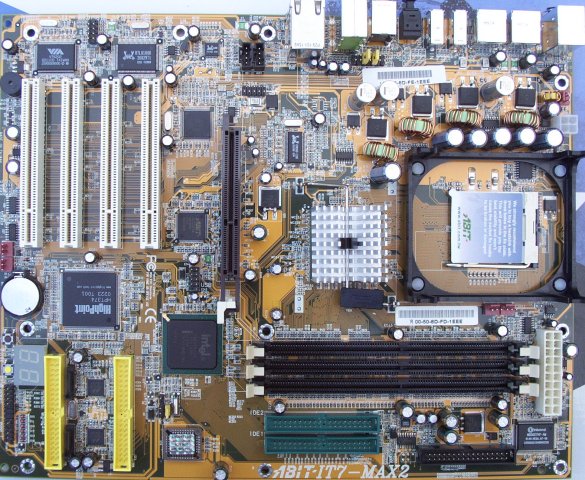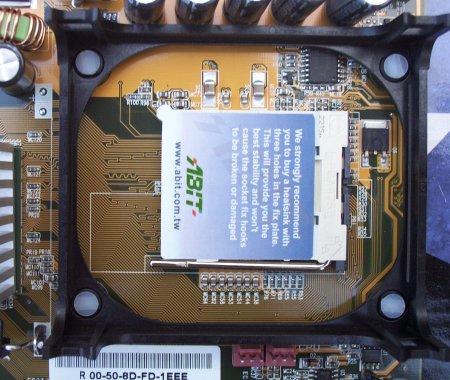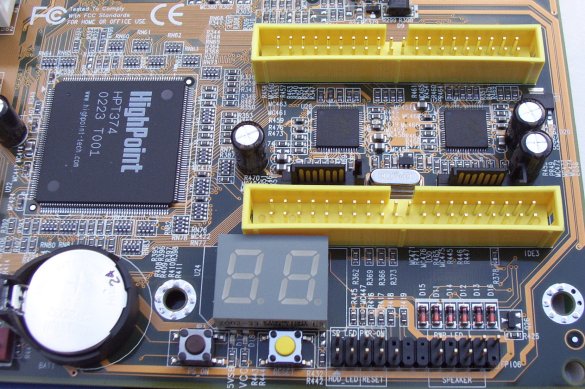Layout and Features

Aficionados will notice that ABIT have gone back to the generic light-brown PCB colour that the original IT7-MAX debuted in. The MAX2 (i845E) had a darker brown PCB. I preferred that one myself. There's no explicit mention of this motherboard being a revision 2.0. Some vendors may well get confused.
At the very right of the above picture we see the first of five fan headers on the IT7, an almost unprecedented number, and sure to delight those who wish to maximise their air-cooling ability. The P4 12v 4-pin connector is very sensibly placed at the top of the IT7, keeping trailing wires away from the main socket. 3 DIMM slots are provided but if you want to populate all three slots concurrently, you have to ensure that modules in slots 2 and 3 are single-sided DIMMS.

The socket has enough room around it to mount an Alpha or Swiftech-class of cooler without too much difficulty. The MCX4000, though, might just have a little trouble with the two fan headers you see above. Notice the IC to the top of the picture ?. It's the seemingly ubiquitous HIP6301 voltage regulation chip. Attach a variable resistor to leg 7 and you can bypass the lack of Vcore on offer. It's in a poor location.
The IDE ports are in a decent location and the AGP slot has plenty of room around it should you wish to mount an aftermarket cooler on your video card. As you can no doubt see, the i845PE Northbridge is cooled passively by a rather imposing heatsink.

Here's a busy corner of the motherboard. The above picture shows the 4-channel RAID on offer courtesy of 2 IDE ports and 2 S-ATA ports. You can just about see the Marvell chips that power the S-ATA ports sandwiched between the yellow RAID ports. The HighPoint HPT374 RAID controller gives you the option of running in RAID0, RAID1, and RAID0+1 for increased reliability. The S-ATA ports work in the just the same way as the standard IDE RAID ports, although you can only use one with the single Serillel converter provided.
The CMOS battery has been mounted horizontally for the first time on the MAX series of motherboards. I preferred the vertical mounting on the previous incarnations. The two buttons you see south of the excellent debug LCD are on / off switches. Handy for testing.

Sitting between the AGP slot and the 4 PCI slots are a couple of interesting chips. Working alongside the ALC650 sound CODEC, the ABIT AC2001A IC (right) provides 6-channel sound that is good for all but the die-hard audiophiles. The Texas Firewire IC on the left provides the circuitry for the 3 on-board Firewire (1394a) connectors. You'll need to invest in a MediaXP box if you're to make use of the third Firewire connection.

On the left of the above picture we see the VIA VT6202 USB2.0 Host Controller. The controller supports 4 downstream USB2.0 ports, 2 of these are pre-soldered onto the backplane, and a further 2 are available from a separate header. Added to the 6 natively supported by the ICH4, we have 10 on offer. (although only 8 catered for via brackets and ports).
We also see the inclusion of a Realtek RTL8100BL 10/100 Base-T Fast Ethernet Controller. Onboard Ethernet is becoming more and more prevalent nowadays with the increased use of networking and broadband internet. As the IT7-MAX2 v2.0 only has 4 PCI slots, it makes great sense to include an integrated Ethernet connection. The RTL8100BL was an able substitute for my preferred NIC, the D-Link 530TX.
You also have the option of connecting up various external memory sources such as Sony's memory stick and Panasonic secure digital cards along with standard compact flash cards.

The backplane keeps the PS/2 ports that were reintroduced on the MAX2. What we see here are the PS/2 ports, 4 USB2.0 ports, 2 Firewire ports, S/PDIF out, audio jacks (centre, surround, front speakers, line-in, and mic-in), a further 2 USB2.0 ports and the 10/100 RJ45 LAN socket.
There's an extra Firewire and USB2.0 port that isn't catered for immediately. I would have liked it if ABIT had bundled a 'lite' version of their Media XP module, such that you could use all the ports on offer immediately.
For a motherboard that makes use of so many extra integrated circuits the IT7-MAX2 v2.0 is laid out well. Thought has been given to the positioning of components with the end user in mind.









